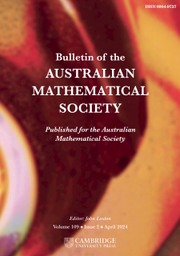No CrossRef data available.
Article contents
AN UPPER BOUND ON THE LENGTH OF AN ALGEBRA AND ITS APPLICATION TO THE GROUP ALGEBRA OF THE DIHEDRAL GROUP
Published online by Cambridge University Press: 10 February 2025
Abstract
Let  ${\mathcal {A}}$ be a unital
${\mathcal {A}}$ be a unital  ${\mathbb {F}}$-algebra and let
${\mathbb {F}}$-algebra and let  ${\mathcal {S}}$ be a generating set of
${\mathcal {S}}$ be a generating set of  ${\mathcal {A}}$. The length of
${\mathcal {A}}$. The length of  ${\mathcal {S}}$ is the smallest number k such that
${\mathcal {S}}$ is the smallest number k such that  ${\mathcal {A}}$ equals the
${\mathcal {A}}$ equals the  ${\mathbb {F}}$-linear span of all products of length at most k of elements from
${\mathbb {F}}$-linear span of all products of length at most k of elements from  ${\mathcal {S}}$. The length of
${\mathcal {S}}$. The length of  ${\mathcal {A}}$, denoted by
${\mathcal {A}}$, denoted by  $l({\mathcal {A}})$, is defined to be the maximal length of its generating sets. We show that
$l({\mathcal {A}})$, is defined to be the maximal length of its generating sets. We show that  $l({\mathcal {A}})$ does not exceed the maximum of
$l({\mathcal {A}})$ does not exceed the maximum of  $\dim {\mathcal {A}} / 2$ and
$\dim {\mathcal {A}} / 2$ and  $m({\mathcal {A}})-1$, where
$m({\mathcal {A}})-1$, where  $m({\mathcal {A}})$ is the largest degree of the minimal polynomial among all elements of the algebra
$m({\mathcal {A}})$ is the largest degree of the minimal polynomial among all elements of the algebra  ${\mathcal {A}}$. As an application, we show that for arbitrary odd n, the length of the group algebra of the dihedral group of order
${\mathcal {A}}$. As an application, we show that for arbitrary odd n, the length of the group algebra of the dihedral group of order  $2n$ equals n.
$2n$ equals n.
Keywords
MSC classification
Information
- Type
- Research Article
- Information
- Bulletin of the Australian Mathematical Society , Volume 112 , Issue 1 , August 2025 , pp. 139 - 148
- Copyright
- © The Author(s), 2025. Published by Cambridge University Press on behalf of Australian Mathematical Publishing Association Inc.
Footnotes
This research was supported by Russian Science Foundation, grant 20-11-20203.


